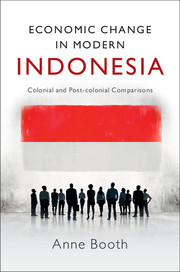Book contents
- Frontmatter
- Contents
- List of tables
- Acknowledgements
- 1 Introduction: Indonesia's three watersheds
- 2 The colonial legacy
- 3 Occupation, liberation and the challenges facing the new republic, 1942–66
- 4 Suharto's economic record: successes and failures
- 5 The 1997–98 crisis and its legacy: dropping out again?
- 6 The SBY years: building a new Indonesia?
- 7 Economic nationalism, economic rationalism and the development of private business after 1950
- 8 Trends in poverty and income distribution: the Suharto era and beyond
- 9 The changing role of government from the colonial era to the post-Suharto years
- 10 Conclusions
- Bibliography
- Index
5 - The 1997–98 crisis and its legacy: dropping out again?
Published online by Cambridge University Press: 05 February 2016
- Frontmatter
- Contents
- List of tables
- Acknowledgements
- 1 Introduction: Indonesia's three watersheds
- 2 The colonial legacy
- 3 Occupation, liberation and the challenges facing the new republic, 1942–66
- 4 Suharto's economic record: successes and failures
- 5 The 1997–98 crisis and its legacy: dropping out again?
- 6 The SBY years: building a new Indonesia?
- 7 Economic nationalism, economic rationalism and the development of private business after 1950
- 8 Trends in poverty and income distribution: the Suharto era and beyond
- 9 The changing role of government from the colonial era to the post-Suharto years
- 10 Conclusions
- Bibliography
- Index
Summary
The onset of the economic crisis
By early 1997, episodes of ethnic and religious violence were erupting in several parts of the country, while the ongoing problems in Aceh, Irian Jaya and East Timor appeared incapable of resolution. Many were wondering for how much longer Suharto could continue to rely on the loyalty of the army in carrying out brutal and unpopular ‘pacification’ activities in far-flung parts of the country. But to most observers, both within Indonesia and abroad, the economy still appeared strong. Both domestic and foreign economists, including respected economic journalists and multilateral lending organisations such as the World Bank and the Asian Development Bank, praised the Indonesian government for its adherence to sound macroeconomic management. Budget deficits had been kept low, inflation was well under control, and the balance of payments deficit at around 4 per cent of GDP seemed far less worrisome to most observers than the much higher deficits in Malaysia and Thailand. Certainly there was some concern that there was a growing reliance on short-term capital inflow to fund the current account deficit but again this trend did not seem nearly so pronounced as in Thailand. It was known that some conglomerates were borrowing large sums offshore but this was not seen as something the government could or should concern itself with.
The problems in Thailand came to a head in early July 1997, when the Thai authorities were forced to float the baht, which then depreciated rapidly. The rupiah came under pressure soon after the Thai decision to float the baht, and after apparently futile attempts by Bank Indonesia to stabilise the rupiah, it was decided that from 14 August, the rupiah could float freely. This was a decisive break with previous exchange rate management in Indonesia, and IMF officials were quoted as applauding the move. The president and other senior officials stressed that economic fundamentals in Indonesia were sound, and that there was no reason for panic (Lindblad 1997: 5–8). But by early October, serious problems were emerging. Capital outflow was accelerating, and the rupiah was trading at 3,600 to the dollar, compared with 2,500 in July. The government then turned to the International Monetary Fund (IMF) for a standby loan.
- Type
- Chapter
- Information
- Economic Change in Modern IndonesiaColonial and Post-colonial Comparisons, pp. 89 - 105Publisher: Cambridge University PressPrint publication year: 2016



